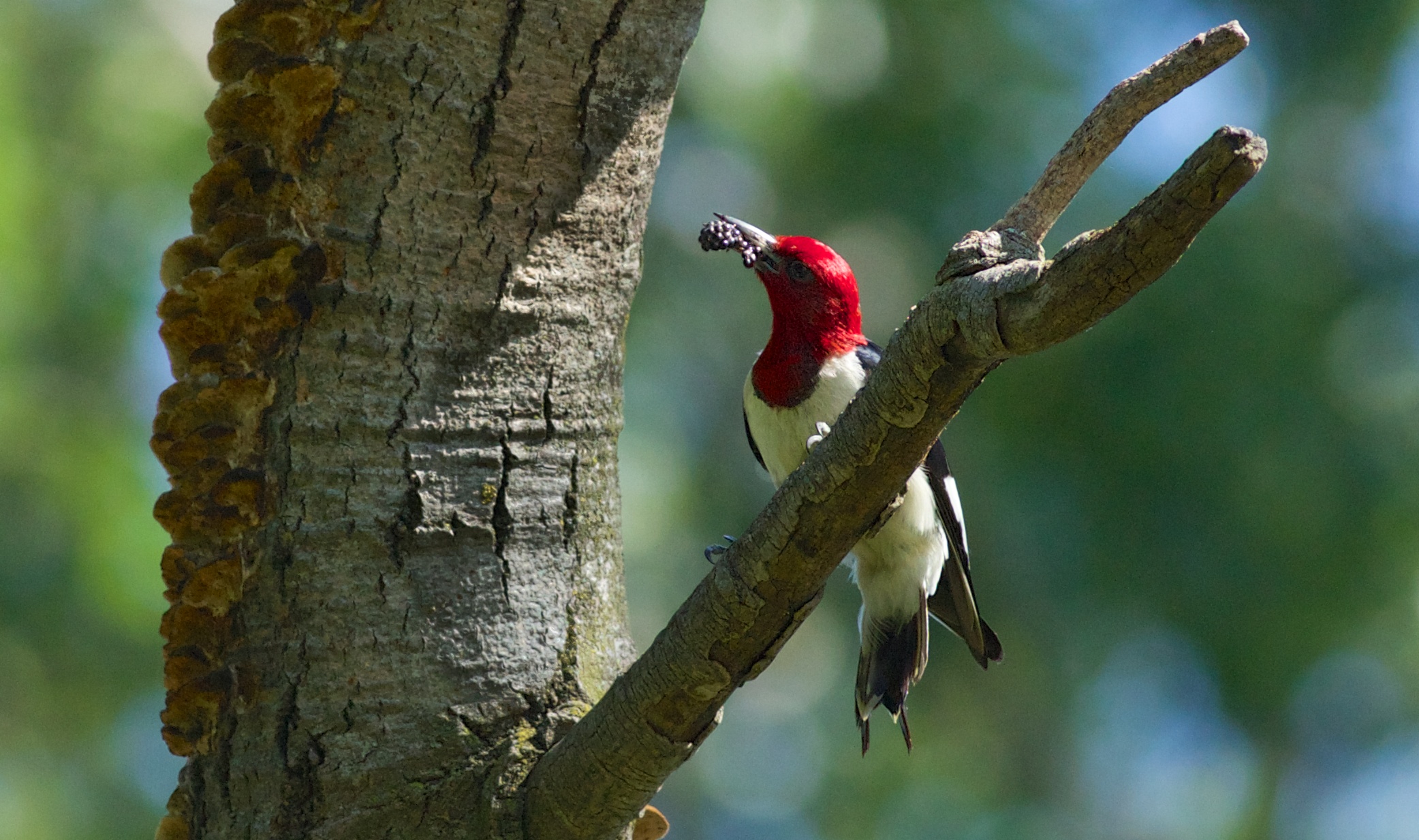It’s berry season at Fair Meadows Sanctuary! A recent article reported on a study showing that migratory birds chose to feast on native berries and almost entirely ignored non-native fruit.
Photo by Gary Shackelford
Friday Feathered Feature
Showcasing a different bird species each week
It’s berry season at Fair Meadows Sanctuary! A recent article reported on a study showing that migratory birds chose to feast on native berries and almost entirely ignored non-native fruit.
Photo by Gary Shackelford
One of the most dazzling birds in Wisconsin simultaneously occurs in one of the most enchanting natural communities. The red-headed woodpecker in an oak savanna is a sight to behold.
Not to be confused with red-bellied woodpeckers, which also have a red head, the red-headed woodpecker has a sparkling crimson head, neck, and face while red-bellied woodpeckers only have red on the back of the head with gray faces and throats.
You might notice the red-headed woodpecker in flight among oaks trees with an open understory, and you can't miss its jet black fathers, checkered with pure white on parts of the wing, tail, and the entirety of the breast.

Red-headed woodpecker, photo by Arlene Koziol
A purposeful bird, this woodpecker's flight takes a more direct path than other woodpeckers, and you'll typically see red-headed's flying rather straight routes from oak to oak and dead snag to dead snag. It's a bird that, when observed, seems to have no indecision.
An area of varied decision-making comes with the bird's diet, which is omnivorous and among the most diverse of all woodpecker diets. Insects make up a large proportion of prey items during summer, and red-headed woodpeckers are experts at catching insects mid-air. They will also consume and cache acorns, which are supplemented by fruits, nuts, seeds, mice, eggs, and even snakes and lizards.

Red-headed woodpecker, photo by Arlene Koziol
Moreover, in studies of woodpecker habitat partitioning, red-headed woodpeckers were found to forage the full range of a dead snag, from top to bottom, and showed no preference for small or large diameter snags, whereas a bird like the downy woodpecker will forage on small diameter trees at restricted ranges.
Hardy enough to spend the winter in Wisconsin, a few red-headed woodpeckers remain each year, but many will migrate slightly south of the snow line. A study in Missouri found that high mast production of acorns, walnuts, and hickories was related to high overwintering numbers of red-headed woodpeckers; it's likely that those birds overwintering in Wisconsin found an excellent crop of acorns.

Red-headed woodpecker and nestling, photo by Arlene Koziol
Additionally, the birds lay 4 to 7 eggs, with some laying up to ten, and red-headed woodpeckers will often raise a second brood.
With its range of adaptations, one might expect the red-headed woodpecker to be common throughout the state. However, the bird is a Wisconsin species of Special Concern, and the North American population has been cut in half over the past few decades, while the Wisconsin population has declined 60-70%.
It's impossible to pin down an exact cause of this mysterious decline, but let's use Faville Grove Sanctuary as an example of how these populations have declined (and how they can recover).
The Lake Mills Ledge has been restored to an oak savanna with scattered, large diameter bur and white oak trees. After pasturing ceased decades ago—and due to fire suppresion—buckthorn and honeysuckle invaded the understory, and black cherries, elms, and boxelders profused between and among the oak trees. This led to canopy closure, and the restricted space didn't allow red-headed woodpeckers to catch insects or survey from perches.
It's also possible that dead trees and snags were removed from this small forested stand and used for firewood, which would have effectively eliminated nesting cavity habitat for the woodpeckers. Prior to habitat acquisition and restoration, the Lake Mills Ledge was a small island in an agriculturally dominated landscape—where European starlings were frequent, and likely attacked any red-headed woodpeckers inspecting a cavity.

Spring in a Wisconsin oak savanna, photo by Joshua Mayer
The effect of restoration on this small savanna has had tremendous positive effects on the red-headed woodpeckers. Clearing of invasive brush and trees has restored the savanna structure, and provides the vistas that red-headed woodpeckers use to pick out prey items. Girdling (removing the cambium and disrupting the flow of nutrients, which kills the tree) of select trees, including a clump of large diameter black willow, has allowed for the desirable characteristics that red-headed woodpeckers look for in a home: large diameter trees flushed of bark, clusters of dead snags, and a high density of dead limbs, especially limbs close to the ground. Lastly, the restoration to native plant communities in the surrounding landscape has made it less likely that starlings will attempt to disrupt nesting activities.
This habitat restoration has proven beneficial to other species as well. Last year we found breeding bluebirds, northern flickers, and downy woodpeckers among the snags.
Red-headed woodpeckers are not an area-sensitive species, meaning they don't need large tracts of habitat for breeding success. Rather, a few dead trees mixed among some living oaks will do just fine. Thus, there is opportunity for private landowners and urban areas to restore populations of red-headed woodpeckers. The solutions prove to be rather simple: cutting invasive brush, and thinning and girldling trees. While the bird's decline remains mysterious, its recovery is less so.
Written by Drew Harry, Faville Grove Sanctuary land steward